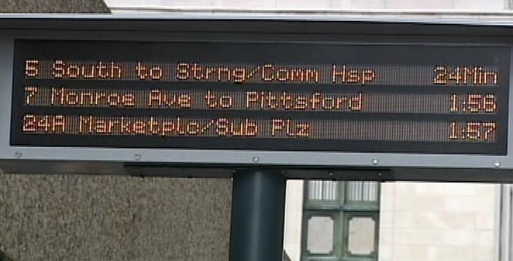Send This to the NFTA
The NFTA is staring down a $10 million deficit.
Nevertheless, the authority is planning no layoffs or fare hikes – at least not yet – as it pleads for greater funding from Albany. All public transit systems require government subsidies to operate, but it won’t be enough for Albany simply to shovel more money in the NFTA’s direction.
There will also have to be a re-evaluation of what the authority’s mission is and what it should be doing differently to accomplish it.
The News suggests that the NFTA needs to figure out a better way to serve the growing medical campus, adding that,
For 20 years, it has used money meant for capital projects to balance its operating budget.
That money has now dried up. There is less money for maintenance, meaning broken escalators don’t get fixed and old buses aren’t replaced. That further discourages riders from using the system, further pinching the authority’s financial resources.
NFTA Commissioner Kimberly A. Minkel had it exactly right: Unless it’s interrupted, the NFTA is caught in a “death spiral.” The problems will feed on one another until only a skeleton of a transit system remains. That cycle, therefore, must be interrupted, and Albany is the only likely source of intervention.
The News notes that Buffalo’s urban poor rely heavily on the NFTA’s service. This is true, but limiting the NFTA’s scope to just serving people who can’t afford cars is self-defeating. Begging Governor Cuomo for more aid is hardly the solution to a longstanding, systemic “death spiral”.
The News’ editorial essentially rejects the notion that the NFTA could or should fix itself or aim any higher than the faded and tired service it provides to Buffalo’s underclass.

RochesterSubway.com
You don’t have to look too far. Rochester’s RGTRA was $27 million in the hole in 2004, with an annual budget of $70 million. It was, at the time, in “a crisis situation looking at service cuts and layoffs when the authority was looking for a new CEO.” Fast forward a decade,
RGRTA had a six-zone, complicated system and the fares were between $1.25 and $3.10. The cost recovery at the time was 28 percent and the on-time performance was 76 percent.
Today it is paying employees more, healthcare costs have gone up and fuel costs more, but despite that, it has become less reliant on taxpayer dollars than it was before.
It’s also grown to 840 employees, more than 400 vehicles, an on-time performance up to 90 percent, it’s eliminated the six-zone system and went to one fare for all rides. In 2008 the fares went from $1.25 to just $1.00 for a ride. And the cost recovery is up to 41 percent.
This strategic shift is something the team has been really focused on, [RGTRA CEO Mark] Aesch says. RGRTA has increased ridership six consecutive years, up to just shy of 18 million folks a year and it has had five straight years of surpluses and will have made $33 million over the last five years.
I don’t know if the NFTA has the brains or will to hire someone as effective as Mr. Aesch, but luckily he wrote a book about his experience. Basically, the RGTRA re-focused its goal from “save money” to “achieve excellence”. In this interview, he explains that the RGTRA board was, in 2004, in the same boat as the NFTA is now, and the board recognized the crisis, a business-oriented board with a clearly defined notion of success, and a willingness to make bold decisions. (Here’s another article about Rochester’s amazing success).
Instead of a survivor mindset, which would result in just cost savings, they pursued excellence.
“Some people would say we’ve cut service. No, we were looking to drive productivity,” he says. “We were strategically trying to become more efficient in our delivery to the community.”
He continues, “They look at other people and they say, ‘We’re going to cut service on some route.’ Well, there are two people riding it.
“You’re going to jeopardize 60,000 people a day over two people that you’re running a bus one way 30 miles for? I’m not sure that’s cutting service, I think that’s silly.” He stresses, “It’s all very strategically driven.”
There were two changes that were critical to this process. One was changing the thinking from customers to passengers and the other was becoming less reliant on tax dollars.
“We wanted to get us to no longer pick up passengers but to pick up customers,” Aesch says. “You can easily get people to just parrot that. ‘Fine, if the boss wants us to call them customers instead of passengers, that’s what we’ll call them.’
“But it’s getting people to culturally think of it differently.”
Specifically, the change in language was key to changing the corporate mindset – a passenger is someone with no choice, Aesch says.
In “Driving Excellence,” he says he tells the story of one of their employees that he had an encounter with. “He essentially said, who cares if we get the buses cleaner, they were riding before, what difference does it make if we make them cleaner?”
A big difference, as it turns out. Bus cleanliness is important to the customer. Even the very poor customers who have no choice.
What changed it at RGRTA was putting together a plan with a vision, strategies, operating tactics and a measurement system so that everybody can follow where the agency is headed.
And in six years Aesch says they haven’t adopted a budget, they adopt a plan.
The plan is the vision statement that he says tells them what they are trying to be “when they grow up.” The plan also outlines the strategies needed to implement to achieve that vision.
The last piece, he says, is aligning the money to realize those operating tactics and then building a measurement system to outline whether they are successful.
“One thing I just love about the plan more than anything, this is very transparent, we put this out in front of everybody so for each one of our four strategies … we say 14 months ahead of time on March 31, 2011, ‘The authority is successful if,’ and there are numbers with each one of these things.
Vision and plan? On Planet Byron Brown? Is this even possible? Is this real life? Aesch went on to rally the troops and hold a pep rally when things started to look up.
“What I said to the employees was, if you felt like you helped this year, to dig us out of this massive hole to succeed, you can come up now and we’re all going to sign the letter submitting the plan to the board for the coming year. “
He explains how they ended the pep rally, with U2’s “Beautiful Day” playing in the background, the high energy and excitement in the garage and employees coming up and signing their plan.
One of the drivers that had challenged policies when Aesch came on board, came up at the rally and said he wasn’t going to sign the letter.
“He’s looking down — tall guy — and I said, ‘That’s OK, Caesar, don’t sign the letter.’” And Aesch says he was thinking at the time, “Don’t bring me down on a day that’s exciting.”
The driver said he couldn’t sign the letter. “I kind of hesitated for a minute thinking if he can’t read or write, that’s not why he’s going to sign?
“He says, ‘I’m not going to sign the letter because I don’t deserve to. I didn’t help, I was in the way, I was an obstacle, but this coming year I will help, I will do the right things, I will advance the organization and next year I’ll be able to sign the letter.’”
I’m pulling so many quotes because I love everything about this whole story about how Rochester’s mass transit system pulled itself out of mediocrity, and wishing to God almighty that the NFTA takes a cue from the people 60 miles to the east.
They recruited RIT to help test everything that the RGTRA uses.
One of the areas they’re working together on is with the vehicle diagnostic testing pre-breakdown so when testing equipment, it will send an automatic signal back to radio control before the bus breaks down, telling them the bus is thinking about breaking down.
And this – the NFTA could, at the very least, do this.
And when he talks about technology advancements, Aesch stresses that it’s all about achieving a strategy. Another that they’re in the process of is rolling out signage at stops to let riders know when buses are coming.
“We’re not putting them up because they’re cool,” he says. “About 70 percent of our customers who call our call center are looking for information on timeliness of when the next bus will be. Seventy percent.
“We’re doing this investment to help reduce the number of incoming calls to the call center so that we will be able to address that from an efficiency perspective.” He stresses, “It’s a very specific investment that we’re making.”
When you stop thinking of riders as mere passengers and start thinking of them as customers with a choice to take – or not take – the bus, you improve service and results. The service started partnering with schools and businesses to get subsidized routes.
Talking about their partnership with RIT leads to a discussion of how RIT subsidizes the route and that it’s not the typical “paying for passes” that many educational institutions have with transit properties.
“Businesses would typically say, ‘Well I pay taxes, so run a bus, bring me customers, bring me employees.’ Our reaction to that is, you also pay taxes to have water lines put in but you don’t expect to just get your water for free, you’re clearly going to get a water bill at the end of the month for the water that your company consumes. So if we’re going to extend a bus line to bring you customers to shop at your mall or employees to work at your nursing home or students to go to your college, we will enter in to a business relationship to deliver that to you.”
When providing service to the community, RGRTA questioned whether the responsibility of the agency is to provide a bus to provide service to people who ride it or if it’s to take as little money from the taxpayers to support it.
“After chewing on that for a couple months, we decided the answer was, ‘Yes,’” Aesch says. “What we did is we took and built a measurement system which takes the service side: how many people are on board a bus, and we give it a score. Then we take the cost recovery side: how much does the taxpayer have to put in, and then we give the bus a score.
“Then we add those two together and that tells us the answer to how are we doing and rather than ‘cutting service,’ as so many folks are apt to do, we’re able to go in with a microscope and then a scalpel.”
As he explains, if there are a lot of people on board a bus but very low cost recovery, there is a service obligation to provide that service. Conversely, if there are only a handful of people on board the bus but it has a high cost recovery score because it’s a subsidized route, the taxpayer’s not putting money in.
“What we’re looking for is, where do we have very few people, or nobody, and where is the taxpayer paying and that’s where we get the microscope and the scalpel to find those kinds of trips. We’re looking to balance all the time,” he says.
So please send this to the NFTA board and urge them to learn the lessons and implement the strategies that improved service and saved the RGTRA from an identical crisis a decade ago. There are no excuses – Rochester is similarly situated to Buffalo in every conceivable way. By 2011, the RGTRA had been running five consecutive years of surpluses, while ridership and revenue both improved.
[Aesch] suggests to other agencies: Build a road map, have a plan and have a measurement system which tells you whether or not you’re being successful in the implementation of your plan. And the last piece he says is to have the courage to make the right decisions.
Aesch will be leaving RGRTA at the end of the year. He really likes what he does and he says he’s really proud of how they do it, but the part that really excites him, that he’s really passionate about, is the public sector management piece.
He says, “It happens to be public transit today, but whether it’s a hospital, a school district or a sewer system, I like being able to take what people traditionally see as stodgy, tired government bureaucracy and turn that into a lean, mean efficient, less-taxpayer-dollars-needed business mindset organization.”
The NFTA can do it, if it wants to.







